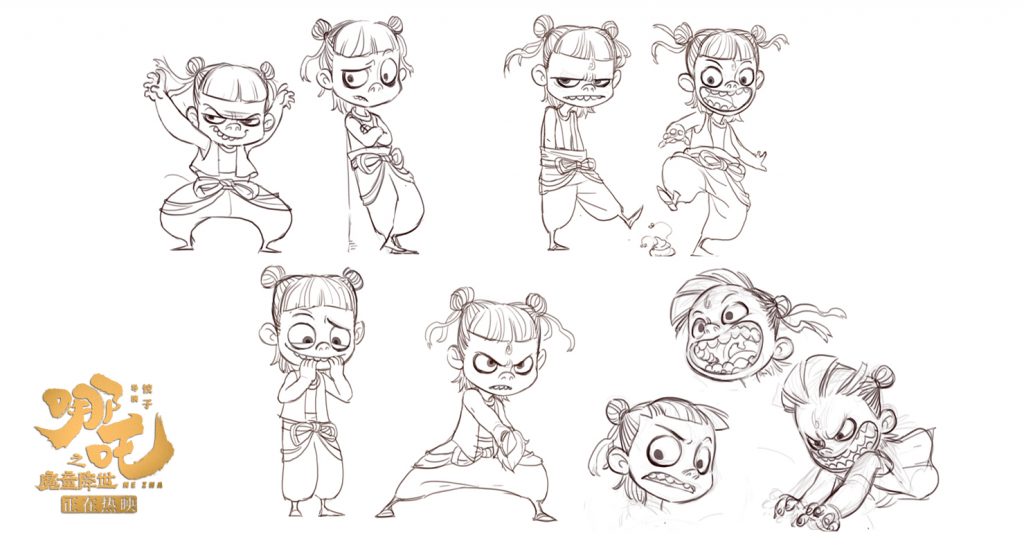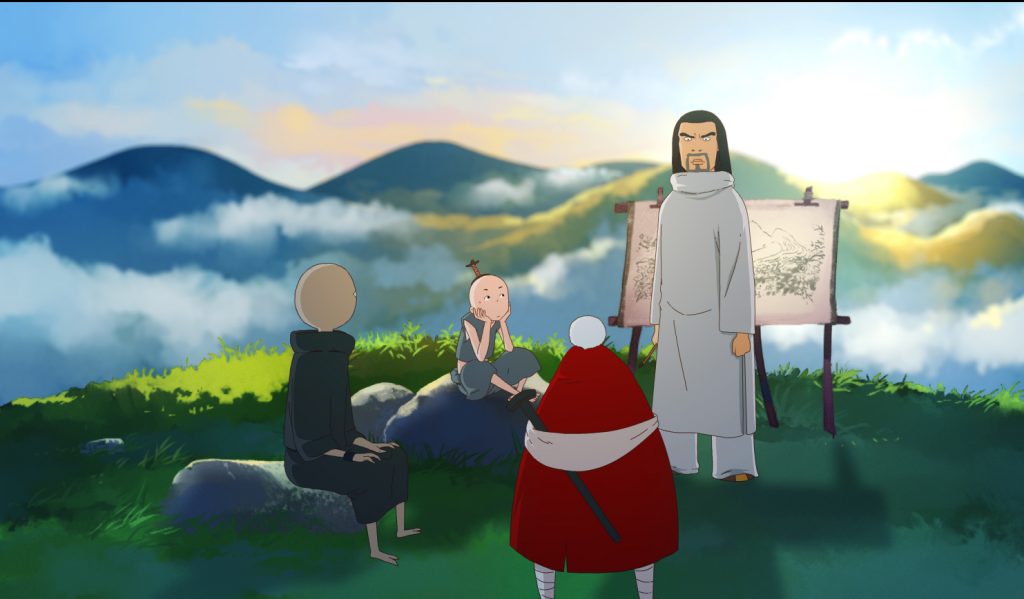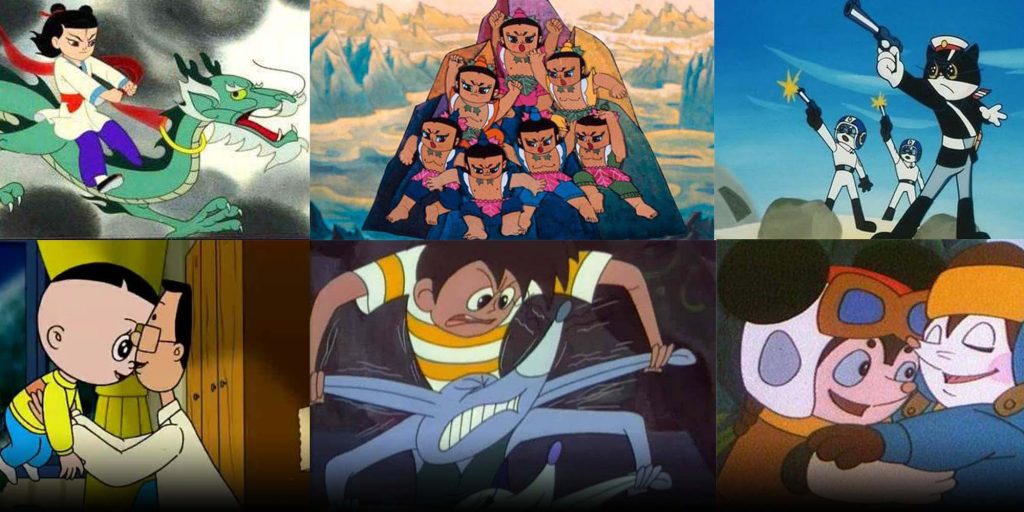As ‘Ne Zha’ sets box-office records amid online animation boom, film makers call it only a start toward sustainable entertainment success.
To most Chinese, the rebellious and fearsome boy depicted in the animated film “Ne Zha” isn’t exactly the protection deity they would expect based on the well-known ancient Ne Zha folk legend. But that hasn’t stopped the unconventionally adapted movie from becoming a booming success.
The animated version of the legend tells the story of a devilish boy reborn as a god to save his people. In six weeks on the big screen through Sept. 10, the film generated 4.8 billion yuan ($6.8 billion) of box-office sales. That made it so far the second-highest grossing film in China behind last year’s action blockbuster “Wolf Warrior II,” marking an impressive milestone for China’s home-grown animated films.
Off the big screens, Chinese audiences’ enthusiasm for domestic animated series has also heated up following the launch on major internet platforms of several popular shows such as “Mo Dao Zu Shi,” an animated fantasy.
The wave of successful productions led by “Ne Zha” is fueling expectations that the long-awaited takeoff of China’s domestic animation industry is approaching. Investors and market players have been betting on a boom since 2015 as private equity investment funds poured into the animation sector.
“Throughout 2015, I met at least 100 or maybe 200 investors,” said Qian Xiaoyu, general manager of animated film studio CGYear. “All of a sudden, everyone is looking for animation projects to invest in.”
Investors’ interest led to a flourishing year for China’s animation industry in 2016 with a record 125 investment deals. Capital support made it possible for several successful projects and promoted a shift in the industry to expand the target audience from kids to more adults.
Since 2015, several animated films have attracted broad attention for their high quality and strong box-office performance. “Monkey King: Hero is Back,” loosely adapted from the 16th century Chinese classical novel “Journey to the West,” set a record with 957 million yuan of ticket sales. Other widely lauded productions include “Big Fish & Begonia,” a stirring adventure and poignant love story, and “White Snake,” inspired by the traditional Chinese fable Legend of the White Snake.
At the same time, big market players have emerged in the animation industry led by Coloroom Pictures, the animation arm of Beijing Enlight Pictures which distributed “Ne Zha”; Light Chaser Animation Studios; and CMC Capital Partners-backed Pearl Studio. Leading internet companies including Tencent Holdings and iQiyi have also joined with film studios to develop animated shows.
China’s animation industry is on a rising path after a long period of slow growth, signaling huge market potential, analysts said. Investors are also turning to animation as production costs are lower without casts of real people and with relatively less regulatory risk, they said.
Amid market cheers, some industry insiders are urging caution. Wang Juan, vice president of Tencent’s filmmaking arm Tencent Penguin Pictures, warned that the influx of capital without professional background will lead to bubbles and distortion in the industry.
“Everyone will pay for the bubble,” Wang said.
Amid the investment splurge on animation since 2015, some studios over-expanded and quickly failed. Capital is “blind,” said Shen Leping, chairman of Sparkly Key, a Hangzhou-based animation studio.
Despite the seemingly flourishing market, the number of China’s animation film companies and projects has yet to show an obvious increase from before 2015, said Lu Wei, chief executive of Octmedia, the distributor of “Monkey King: Hero is Back.”
“The industry is promoted by creativity, not capital,” Lu said.
Tencent’s Wang said there is still a long way to go for China’s animation industry to mature, reflecting a lack of technology, talent and rational business partners. In an animation survey by iResearch, 51.6% of respondents said they preferred Japanese animations while 32.6% cited Chinese productions. Many said domestic animation lacked fresh story ideas and creativity.
Most of the recent successful animations including “Monkey King” and “Ne Zha” were adapted from well-known folk legends.
“After decades, the young generation is still watching the same stories about ‘Monkey King’ and ‘Ne Zha’ as we did in our childhoods,” a film distribution manager said.
The industry faces constraint from a lack of talent, analysts said. About 50,000 professionals worked in the core development section of China’s 150 billion yuan animation industry, a shortfall of 1 million people, research showed.
China’s leading universities started to set up animation-related majors only since 2000, and many of their graduates have been attracted by the higher-paid online game industry, CGYear’s Qian said.
It might be too early to call it a resurgence for China’s animation industry.
“When there is only one animation with 5 billion yuan of box-office sales, we can only call it a start,” Coloroom CEO Qiao said. “We can only call it a resurgence when there are more than five films with more than 1 billion yuan of sales.”
Data from EntGroup showed that 292 animated films were showed between 2015 and August 2019, with average box-office sales of less than 100 million yuan.
The Animated Dream
China’s domestic animation industry has been slow to develop. In the late 1950s, several award-winning animations such as “The Magical Pen,” “Where is Mama?” and “Havoc in Heaven” became a shared memory for a generation of Chinese people and classics in China’s film industry.
But the social and political turmoil rattling the country over the following decades slammed on the brakes for the industry’s development, like most parts of the cultural and entertainment industry. When the economy came back on track after reforms and opening-up started in the late 1970s, China’s nascent animation industry found itself far behind rivals in Japan and the United States.
To play catch-up, industry regulators in 2004 and 2006 launched two rounds of supportive policies to bolster the industry, including preferential taxes, subsidies and restrictions on market access for imported animations.
The policies fueled the first wave of rapid growth in China’s animation industry and the birth of several popular productions such as the TV series “Pleasant Goat and Big Big Wolf” and “Boonie Bears,” but the government-led stimulus also created a bubble that quickly burst.
In 2010, China had more than 6,000 animation companies that produced 220,000 minutes of shows, replacing Japan to become the world’s biggest animation producer. But the huge output far exceeded the demand of China’s TV channels for children’s content, and many of the productions couldn’t be sold. A short boom in the industry was then followed by years of quiet slowdown.
Market Heats Up
Unlike the previous rounds of government-driven market boom, investors and leading industry player are behind the latest wave of animation expansion. Major studios backed by deep-pocketed investors have joined in a game previously dominated by small studios.
In 2013, Wang Wei, the founder of online video platform Tudou.com, set up Light Chaser, which he said will become a Chinese answer to Pixar. Light Chaser attracted high-profile investors such as IDG, Hillhouse Capital Group and GGV Capital. The company launched its first film, “The Guardian Brothers,” in 2016 but received lukewarm market reaction.
Light Chaser first focused on family movies, taking aim at Pixar’s movies series like “Toy Story” and “Finding Nemo.” But such topics are not always popular in China, where most of Pixar’s family-focused films booked less than 100 million yuan of ticket sales, according to Coloroom’s Yi. Instead, more adult-oriented animations such as Pixar’s “Coco” and Disney’s “Zootopia” gained huge success in China with more than 1 billion yuan of sales.
After several loss-making productions, Light Chaser achieved its first success with an adaptation of the ancient love story “White Snake” this year with 450 million yuan of ticket sales.
As Light Chaser shifts its audience target, Chinese investors have taken full control of Pearl Studio, previously a joint venture between a CMC-led Chinese consortium and DreamWorks Pictures. The Hollywood background has provided Pearl Studio a strong foothold in the market. The company plans to release its first independently produced animation “Abominable” in October, an adventure directed by Jill Culton, known for her work on “Monsters, Inc.” and “Toy Story” films.
As the market warms up, Coloroom CEO Yi called for more patience in China’s animation industry.
“The challenge facing the industry is who can help animation authors to get a start and support them to finish,” Yi said.
Coloroom, the company behind “Ne Zha,” was set up by Beijing Enlight Pictures in 2015. In 2016, Coloroom released five animated films in Chinese theaters including the popular “Big Fish & Begonia,” which generated 565 million yuan of ticket sales. The next two years were quiet for Coloroom as it released only three low-budget films. But CEO Yi said it was a time for market cultivation to let Chinese audiences know “there are China-made animation for adult viewers” like those from Pixar and Studio Ghibli.
Before the release of “Ne Zha,” Yi and his team worked nearly five years with director Yang Yu, who goes by the name of Jiaozi, meaning “Dumpling,” on the script and on film production. As the planned debut in summer 2019 approached, Coloroom hired more than 60 production companies and 20 special effects teams to rush completion of the production. The total number of people involved in production of “Ne Zha” exceeded 1,000, and the film finished tightly 20 days before its debut.
While analysts lauded the success of “Ne Zha,” some said its massive production procedure also reflected the immaturity of China’s animation industry.
“Compared with industrialized Hollywood, the production of (“Ne Zha”) is not a normal procedure,” an industry analyst said.
Yi also noted that the heavy human input in “Ne Zha” is not sustainable and the complex outsourcing structure means that the profit margin for the production company will be tiny even with the huge box-office success.
“The industry needs consolidation to form leading production companies that have strong pricing power,” Yi said.
Compared with live-action films, production of animation requires greater process control, which will take time for Chinese filmmaker to develop, Yi said.
In addition, China’s animation industry needs to work out standardized marketing and distribution procedures as well as looking for peripheral business opportunities to expand profit sources beyond ticket sales, analysts said.
Animation movies accounted for 10% of China’s total 60 billion yuan of box-office sales in 2018, still lower than the 15% share in the U.S., according to Zhu Chenghua, CEO of Pearl Studio. Zhu said he expected the industry to maintain rapid growth over the next five years to reach a stable level when opportunities will emerge for consolidation.
“Only a few leading players will remain in the industry,” Zhu said.
– This article originally appeared on Caixin Global.











